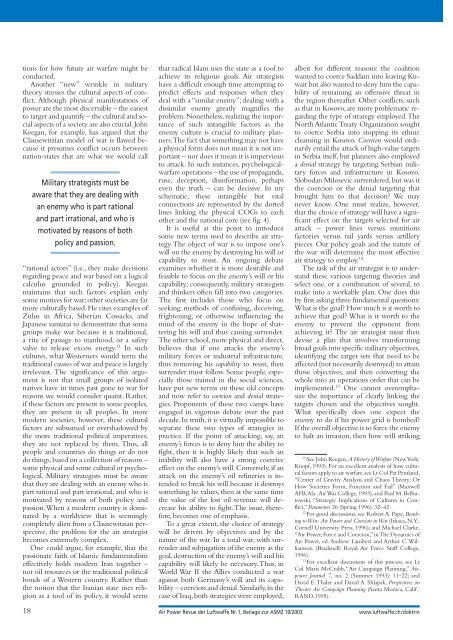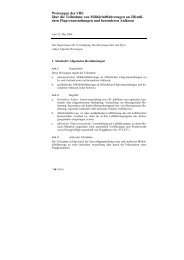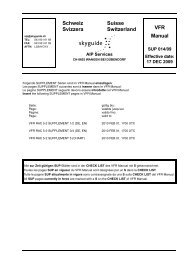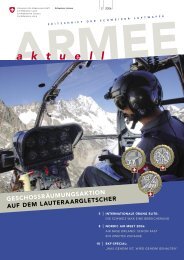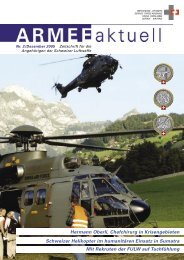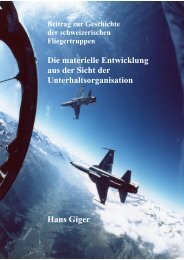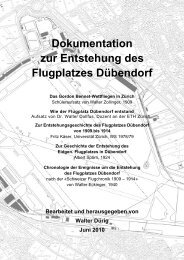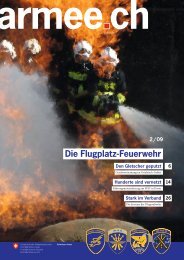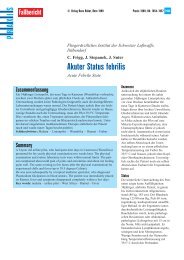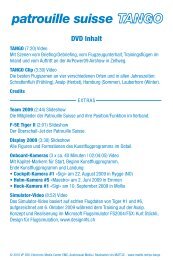AIR POWER REVUE - Schweizer Luftwaffe
AIR POWER REVUE - Schweizer Luftwaffe
AIR POWER REVUE - Schweizer Luftwaffe
Sie wollen auch ein ePaper? Erhöhen Sie die Reichweite Ihrer Titel.
YUMPU macht aus Druck-PDFs automatisch weboptimierte ePaper, die Google liebt.
tions for how future air warfare might be<br />
conducted.<br />
Another “new” wrinkle in military<br />
theory stresses the cultural aspects of conflict.<br />
Although physical manifestations of<br />
power are the most discernible – the easiest<br />
to target and quantify – the cultural and social<br />
aspects of a society are also crucial.John<br />
Keegan, for example, has argued that the<br />
Clausewitzian model of war is flawed because<br />
it presumes conflict occurs between<br />
nation-states that are what we would call<br />
“rational actors” (i.e., they make decisions<br />
regarding peace and war based on a logical<br />
calculus grounded in policy). Keegan<br />
maintains that such factors explain only<br />
some motives for war;other societies are far<br />
more culturally based. He cites examples of<br />
Zulus in Africa, Siberian Cossacks, and<br />
Japanese samurai to demonstrate that some<br />
groups make war because it is traditional,<br />
a rite of passage to manhood, or a safety<br />
valve to release excess energy. 11 In such<br />
cultures, what Westerners would term the<br />
traditional causes of war and peace is largely<br />
irrelevant. The significance of this argument<br />
is not that small groups of isolated<br />
natives have in times past gone to war for<br />
reasons we would consider quaint. Rather,<br />
if these factors are present in some peoples,<br />
they are present in all peoples. In more<br />
modern societies, however, these cultural<br />
factors are subsumed or overshadowed by<br />
the more traditional political imperatives;<br />
they are not replaced by them. Thus, all<br />
people and countries do things or do not<br />
do things,based on a collection of reasons –<br />
some physical and some cultural or psychological.<br />
Military strategists must be aware<br />
that they are dealing with an enemy who is<br />
part rational and part irrational, and who is<br />
motivated by reasons of both policy and<br />
passion.When a modern country is dominated<br />
by a worldview that is seemingly<br />
completely alien from a Clausewitzian perspective,<br />
the problem for the air strategist<br />
becomes extremely complex.<br />
One could argue, for example, that the<br />
passionate faith of Islamic fundamentalism<br />
effectively holds modern Iran together –<br />
not oil resources or the traditional political<br />
bonds of a Western country. Rather than<br />
the notion that the Iranian state uses religion<br />
as a tool of its policy, it would seem<br />
18<br />
Military strategists must be<br />
aware that they are dealing with<br />
an enemy who is part rational<br />
and part irrational, and who is<br />
motivated by reasons of both<br />
policy and passion.<br />
that radical Islam uses the state as a tool to<br />
achieve its religious goals. Air strategists<br />
have a difficult enough time attempting to<br />
predict effects and responses when they<br />
deal with a “similar enemy”; dealing with a<br />
dissimilar enemy greatly magnifies the<br />
problem. Nonetheless, realizing the importance<br />
of such intangible factors as the<br />
enemy culture is crucial to military planners.The<br />
fact that something may not have<br />
a physical form does not mean it is not important<br />
– nor does it mean it is impervious<br />
to attack. In such instances, psychologicalwarfare<br />
operations – the use of propaganda,<br />
ruse, deception, disinformation, perhaps<br />
even the truth – can be decisive. In my<br />
schematic, these intangible but vital<br />
connections are represented by the dotted<br />
lines linking the physical COGs to each<br />
other and the national core (see fig. 4).<br />
It is useful at this point to introduce<br />
some new terms used to describe air strategy.The<br />
object of war is to impose one’s<br />
will on the enemy by destroying his will or<br />
capability to resist. An ongoing debate<br />
examines whether it is more desirable and<br />
feasible to focus on the enemy’s will or his<br />
capability; consequently, military strategists<br />
and thinkers often fall into two categories.<br />
The first includes those who focus on<br />
seeking methods of confusing, deceiving,<br />
frightening, or otherwise influencing the<br />
mind of the enemy in the hope of shattering<br />
his will and thus causing surrender.<br />
The other school,more physical and direct,<br />
believes that if one attacks the enemy’s<br />
military forces or industrial infrastructure,<br />
thus removing his capability to resist, then<br />
surrender must follow. Some people, especially<br />
those trained in the social sciences,<br />
have put new terms on these old concepts<br />
and now refer to coercion and denial strategies.<br />
Proponents of these two camps have<br />
engaged in vigorous debate over the past<br />
decade. In truth, it is virtually impossible to<br />
separate these two types of strategies in<br />
practice. If the point of attacking, say, an<br />
enemy’s forces is to deny him the ability to<br />
fight, then it is highly likely that such an<br />
inability will also have a strong coercive<br />
effect on the enemy’s will. Conversely, if an<br />
attack on the enemy’s oil refineries is intended<br />
to break his will because it destroys<br />
something he values, then at the same time<br />
the value of the lost oil revenue will decrease<br />
his ability to fight.The issue, therefore,<br />
becomes one of emphasis.<br />
To a great extent, the choice of strategy<br />
will be driven by objectives and by the<br />
nature of the war. In a total war, with surrender<br />
and subjugation of the enemy as the<br />
goal,destruction of the enemy’s will and his<br />
capability will likely be necessary.Thus, in<br />
World War II the Allies conducted a war<br />
against both Germany’s will and its capability<br />
– coercion and denial.Similarly,in the<br />
case of Iraq,both strategies were employed,<br />
albeit for different reasons: the coalition<br />
wanted to coerce Saddam into leaving Kuwait<br />
but also wanted to deny him the capability<br />
of remaining an offensive threat in<br />
the region thereafter. Other conflicts, such<br />
as that in Kosovo, are more problematic regarding<br />
the type of strategy employed.The<br />
North Atlantic Treaty Organization sought<br />
to coerce Serbia into stopping its ethnic<br />
cleansing in Kosovo. Coercion would ordinarily<br />
entail the attack of high-value targets<br />
in Serbia itself, but planners also employed<br />
a denial strategy by targeting Serbian military<br />
forces and infrastructure in Kosovo.<br />
Slobodan Milosevic surrendered, but was it<br />
the coercion or the denial targeting that<br />
brought him to that decision? We may<br />
never know. One must realize, however,<br />
that the choice of strategy will have a significant<br />
effect on the targets selected for air<br />
attack – power lines versus munitions<br />
factories versus rail yards versus artillery<br />
pieces. Our policy goals and the nature of<br />
the war will determine the most effective<br />
air strategy to employ. 12<br />
The task of the air strategist is to understand<br />
these various targeting theories and<br />
select one, or a combination of several, to<br />
make into a workable plan. One does this<br />
by first asking three fundamental questions:<br />
What is the goal? How much is it worth to<br />
achieve that goal? What is it worth to the<br />
enemy to prevent the opponent from<br />
achieving it? The air strategist must then<br />
devise a plan that involves transforming<br />
broad goals into specific military objectives,<br />
identifying the target sets that need to be<br />
affected (not necessarily destroyed) to attain<br />
those objectives, and then converting the<br />
whole into an operations order that can be<br />
implemented. 13 One cannot overemphasize<br />
the importance of clearly linking the<br />
targets chosen and the objectives sought.<br />
What specifically does one expect the<br />
enemy to do if his power grid is bombed?<br />
If the overall objective is to force the enemy<br />
to halt an invasion, then how will striking<br />
11 See John Keegan,A History of Warfare (New York:<br />
Knopf, 1993). For an excellent analysis of how cultural<br />
factors apply to air warfare,see Lt Col Pat Pentland,<br />
“Center of Gravity Analysis and Chaos Theory: Or<br />
How Societies Form, Function and Fail” (Maxwell<br />
AFB,Ala.:Air War College, 1993); and Paul M. Belbutowski,<br />
“Strategic Implications of Cultures in Conflict,”<br />
Parameters 26 (Spring 1996): 32–42.<br />
12 For good discussions, see Robert A. Pape, Bombing<br />
to Win: Air Power and Coercion in War (Ithaca, N.Y.:<br />
Cornell University Press, 1996); and Michael Clarke,<br />
“Air Power,Force and Coercion,”in The Dynamics of<br />
Air Power, ed. Andrew Lambert and Arthur C. Williamson<br />
(Bracknell: Royal Air Force Staff College,<br />
1996).<br />
13 For excellent discussions of this process, see Lt<br />
Col Maris McCrabb, “Air Campaign Planning,” Airpower<br />
Journal 7, no. 2 (Summer 1993): 11–22; and<br />
David E.Thaler and David A. Shlapak, Perspectives on<br />
Theater Air Campaign Planning (Santa Monica, Calif.:<br />
RAND, 1995).<br />
Air Power Revue der <strong>Luftwaffe</strong> Nr. 1, Beilage zur ASMZ 10/2003 www.luftwaffe.ch/doktrin


